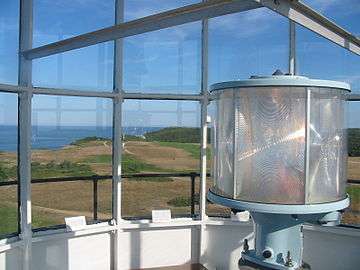VRB-25
The VRB-25 is a lighthouse optical system designed and built by Vega Industries Ltd. in Porirua, New Zealand. It was originally designed in 1993-95 with the assistance of the United States Coast Guard to meet USCG requirements for a robust mechanism requiring minimum maintenance. It has become the Coast Guard's standard 12 volt rotating beacon.[1] The company's literature says there are more than 400 installations worldwide. More than a quarter of the active lighthouses in Maine have one installed.


Components


A microprocessor controlled 12 volt DC motor drives an array of six or eight acrylic Fresnel lenses around a bulb at one of 248 speeds ranging from 0.5 to 15.9 revolutions per minute (RPM). In the simplest case, all six lenses are used, so that for Boon Island Light, which shows one flash every five seconds, the mechanism rotates at two RPM. Eight lenses are used only when required to achieve more complex characteristics.
Maximum range is achieved by using the slowest possible speed, but for grouped flashes, it is necessary to blank off lenses and rotate the mechanism faster. So, for example, for The Cuckolds Light, whose characteristic is group flashing two every six seconds, all but two of the six panels are blanked off and the mechanism rotates at ten RPM.
The mechanism is driven by a DC thirty-pole three phase brushless direct drive motor which consumes approximately 1.5 watts. The microprocessor controller keeps the motor speed within 2% of that chosen through feedback from an alternating black and silver circle on the bottom of the turntable. The unit is designed to accept voltages ranging from 11 to 30 Volts. Since the life of an incandescent lamp decreases dramatically as the applied voltage increases, the lamp voltage is carefully maintained at 12.00V using pulse width modulation.
The lamps, standard marine signal lamps[2] which may be from 10 to 100 watts as required to produce the necessary range, typically have a life of 2,000 hours. The unit contains a bulb changing mechanism which holds six bulbs, so that a unit could go approximately three years between maintenance visits to change bulbs. The acrylic lenses and cylinder surrounding the whole mechanism are designed to be UV resistant, but still require replacement approximately every five years.[3] In practice, since working lights are critical to navigation, the Coast Guard actually services lights more frequently. Except for that maintenance, the unit is expected to last twenty years.
Predecessors and Successors
LED lamps are beginning to replace incandescent lamps in lighthouse applications,[4] so it seems likely that the twenty year replacement will be with an LED light source. In fact, several VLB-44 LED beacons,[5] also made by Vega Industries, have been installed by the USCG, including one at White Island Light.[4]
From the first use of lighthouses with flashing lights, the light source has been continuous. Turning a flame on and off was impractical and flashing an incandescent electric lamp reduces its life substantially. The characteristic seen by the observer has been achieved by rotating a lens system. Since LEDs can be flashed on and off without degrading their lives, it appears that the VRB-25 is the last use of rotating beacons in lighthouses.
Issues
Although the units have been successful in their adoption, there has been occasional controversy (at Egg Rock Light in Maine, for example[6]) when the Coast Guard has removed the lantern from the tower after installing a VRB-25. This seemed logical since the lantern required maintenance and the VRB-25 is designed to sit outside, but it changed the traditional look of the towers. After public protest, a replacement lantern house was installed at Egg Rock Light in 1986. All the VRB-25s listed below, except Piedras Blancas, still have lanterns.[7]
While the beam is visible at its listed range, it is a more focused beam than that produced by a glass Fresnel lens. Some navigators don't like this, finding it harder to see under some conditions.[4] It is easy to see the difference from many points around Boston Harbor, where the VRB-25 at The Graves Light and the 2nd order glass Fresnel lens at Boston Light are both visible. Of course, the original first order Fresnel lens at The Graves stood twelve feet high and weighed several tons. Its many pieces of glass required periodic careful cleaning and alignment.
Examples of Lights using the VRB-25
| Light | Characteristic | Range, nm |
|---|---|---|
| De Tour Reef Light, Michigan | Fl W 10s | 18 |
| The Graves Light, Massachusetts | Fl W (2)12s | 15 |
| Mount Desert Light, Maine | Fl W 15s | 20 |
| Piedras Blancas Light, California | Fl W 10s | 19 |
| Thimble Shoal Light, Virginia | Fl W 10s | 20 |
| West Point Light, Washington | Alt W & R 10s | W 16 and R 13 |
References
- US Coast Guard (2008). Short Range Aids to Navigation Servicing Guide. pp. 3–50.
- US Coast Guard (2002). Major Aids to Navigation Preventative Maintenance Guide. p. 6-E(17)-A-1.
- Vega Industries, Ltd. (2009). VRB-25 Technical Design Paper. p. 3.10.
- Bob Trapani Jr. (2009-09-03). "Vega VRB-25 – Last of the Lighthouse Rotating Beacons as We Know Them".
- Vega Industries, Ltd. (2009-09-04). "VLB-44 LED Marine Beacon" (PDF).
- Rowlett, Russ (2009-09-01). "Lighthouses of the United States: Eastern Maine". The Lighthouse Directory. University of North Carolina at Chapel Hill.
- Rowlett, Russ (2009-09-03). "The Lighthouse Directory". University of North Carolina at Chapel Hill.
_-_cropped.jpg)